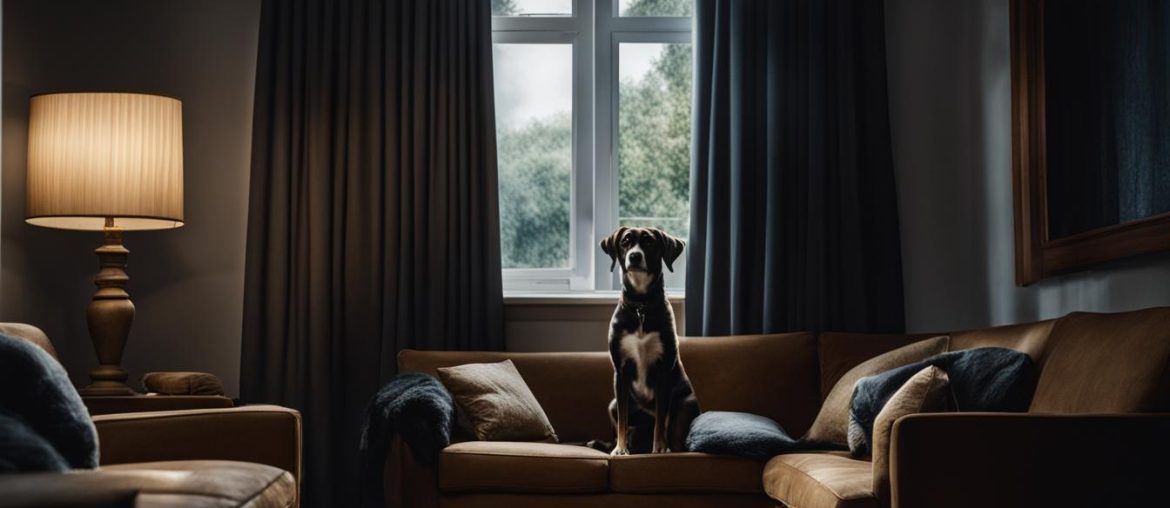Are you struggling with your dog’s separation anxiety? Leaving your dog home alone doesn’t have to be stressful for both of you. With the right training and techniques, you can teach your dog to stay calm and relaxed when you’re away. In this article, I will share valuable tips and solutions to help you train your dog to be alone and prevent separation anxiety.
Key Takeaways:
- Separation anxiety can be prevented by teaching your dog to stay home alone.
- Use crate training to provide a safe and comfortable space for your dog.
- Create positive associations with being alone by offering special treats or toys.
- Practice systematic desensitization by gradually increasing the time your dog spends alone.
- Keep departures and arrivals low-key to help your dog stay calm.
Why Teaching Your Dog To Stay Home Alone is Important
Training your dog to stay home alone is crucial for their overall well-being and can help prevent separation anxiety. Dogs are naturally social creatures and rely on their human companions for companionship and security. However, there are times when leaving your dog alone is unavoidable, such as when you need to go to work or run errands.
Separation anxiety is a common issue faced by many dogs when left alone. It can manifest in various ways, including excessive barking, destructive behavior, and even physical symptoms like panting and drooling. Teaching your dog to stay home alone can prevent these anxieties from developing or worsening, making it easier for both you and your furry friend.
Preventing separation anxiety is much easier than treating it later on. By gradually introducing your dog to being alone and providing them with the tools and resources to cope, you can help them develop a positive association with solitude. This will ultimately build their confidence and independence, allowing them to remain calm and content even when you’re away.
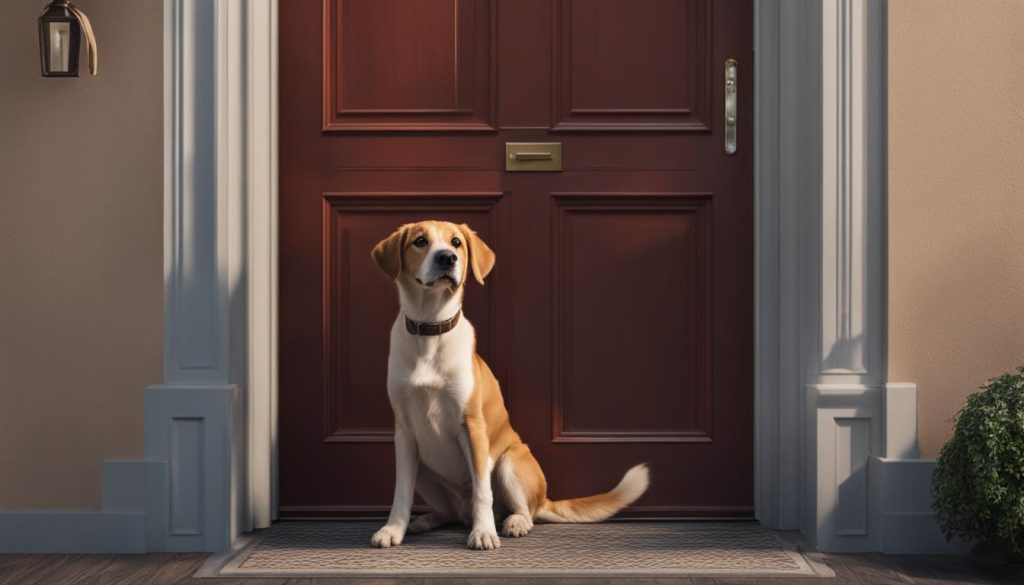
Why is preventing separation anxiety important?
Separation anxiety can severely impact your dog’s quality of life and your ability to leave them alone without worrying. It can lead to destructive behavior, excessive vocalization, and even self-harm in extreme cases. By teaching your dog to stay home alone, you are providing them with the necessary skills and confidence to navigate periods of solitude without experiencing distress.
Crate Training for Alone Time
When teaching your dog to stay home alone, crate training can be a valuable tool to help them feel safe and secure. A dog crate serves as their own personal den, providing a comfortable and enclosed space where they can relax. I would recommend to introduce your dog to the crate gradually and create a positive association with it.
To start crate training, place the crate in a quiet area of your home where your dog can see and hear you. Leave the door open and encourage your dog to explore the crate by placing treats or their favorite toys inside. Allow them to enter and exit the crate freely, without any pressure.
Once your dog becomes more comfortable with the crate, you can start closing the door for short periods. Begin by closing the door for just a few seconds, then gradually increase the duration. Always reward your dog with treats and praise when they remain calm inside the crate.
To put it simply, the crate should never be used as a form of punishment. It should be a positive and safe space for your dog. When done correctly, crate training can help alleviate anxiety and provide your dog with a sense of security when left alone.
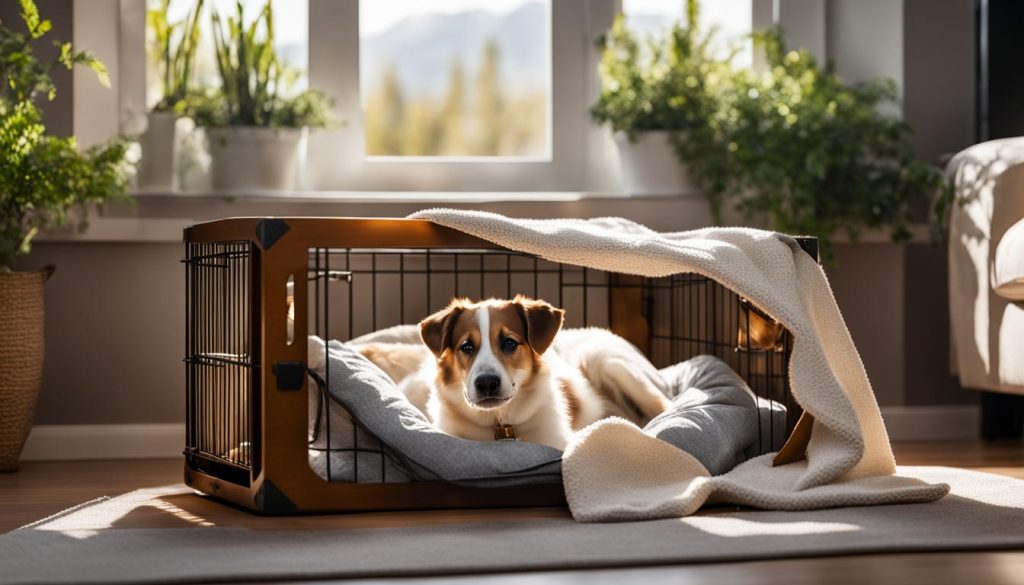
Table: Steps for Crate Training
| Step | Description |
|---|---|
| 1 | Introduce the crate gradually and make it a positive experience |
| 2 | Place treats or toys inside the crate to encourage exploration |
| 3 | Close the crate door for short periods, increasing the duration gradually |
| 4 | Reward your dog with treats and praise for remaining calm in the crate |
Creating Positive Associations
When teaching your dog to stay home alone, create positive associations with being left alone. By using positive reinforcement and counterconditioning techniques, you can help your dog feel more comfortable and relaxed when you’re not around.
One effective way to create a positive association is to give your dog a special treat or toy each time you leave. This can be something that they only get when you’re not home, such as a food puzzle or interactive toy. By associating your absence with something enjoyable, your dog will start to see being alone as a positive experience.
“By using positive reinforcement and counterconditioning techniques, you can help your dog feel more comfortable and relaxed when you’re not around.”
Food puzzles for dogs can be particularly helpful in keeping them occupied and mentally stimulated during alone time. These puzzles require them to work for their food, providing both physical and mental exercise. There are a variety of food puzzle toys available, so you can find one that suits your dog’s preferences and skill level.
To put it simply, consistency is key when creating positive associations. Be sure to give your dog the special treat or toy every time you leave, regardless of how long you’ll be gone. This will help reinforce the positive association and gradually alleviate any anxiety they may have about being alone.
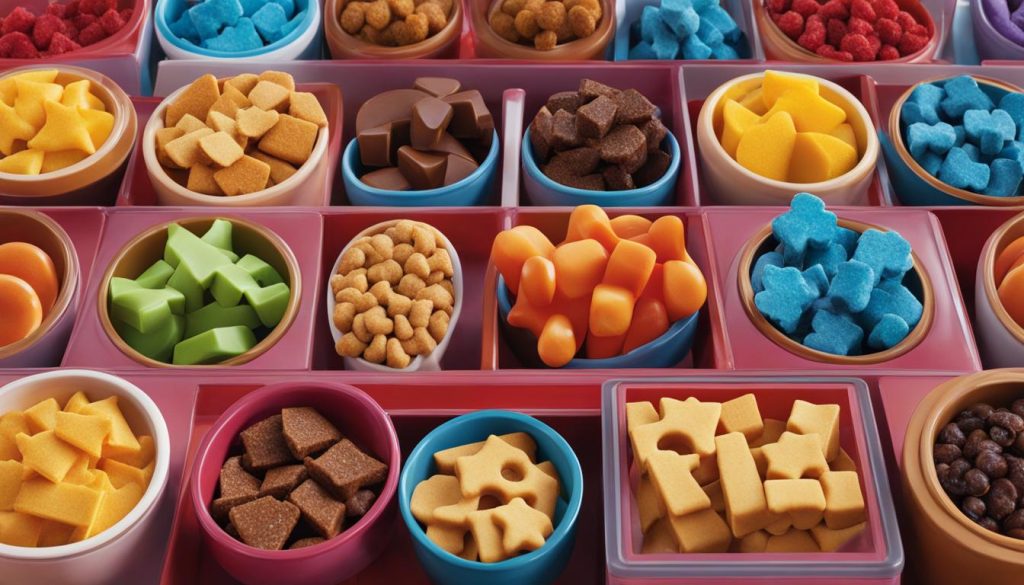
Table: Types of Food Puzzles for Dogs
| Food Puzzle | Description |
|---|---|
| Treat Dispensing Ball | A ball-shaped toy with a small opening that dispenses treats as your dog plays with it. |
| Snuffle Mat | A mat with multiple layers of fabric where you can hide treats for your dog to sniff out. |
| Puzzle Toy with Hidden Compartments | A puzzle toy with different compartments that hide treats, requiring your dog to figure out how to access them. |
| Interactive Feeder | An elevated feeder with obstacles or maze-like designs that make your dog work for their food. |
Start Systematic Desensitization
Systematic desensitization is a technique that can help your dog gradually get used to being alone. By exposing your dog to short periods of time alone and gradually increasing the duration, you can help them develop a neutral association with being alone.
To start systematic desensitization, begin by leaving your dog alone for a few minutes at a time. Make sure to create a calm and comfortable environment for them before you leave. Leave them with a special toy or treat to keep them occupied.
Over time, gradually increase the duration of your absences. Slowly increase the time from a few minutes to 10 minutes, then to 30 minutes, and so on. You should monitor your dog’s behavior during these times and make sure they are coping well. If your dog shows signs of stress or anxiety, take a step back and decrease the duration of their alone time.
Gradual Exposure
Gradual exposure is a key component of systematic desensitization. It allows your dog to become familiar with being alone slowly and at their own pace. By starting with short periods and gradually increasing the time, you are helping your dog build confidence and reduce their anxiety.
As you extend the duration of their alone time, it can also be helpful to vary the times of day and the circumstances under which you leave. This will help your dog generalize their learning and become comfortable being alone in different situations.
| Time Alone | Behavior |
|---|---|
| 5 minutes | Relaxed, no signs of stress |
| 10 minutes | May start to look for you but remains calm |
| 20 minutes | Settles down and engages with toys or rests |
| 30 minutes | Comfortable being alone, no signs of anxiety |
Don’t forget that each dog is unique and may progress at their own pace. Be patient and consistent with your training, and always monitor your dog’s behavior for any signs of stress or anxiety.
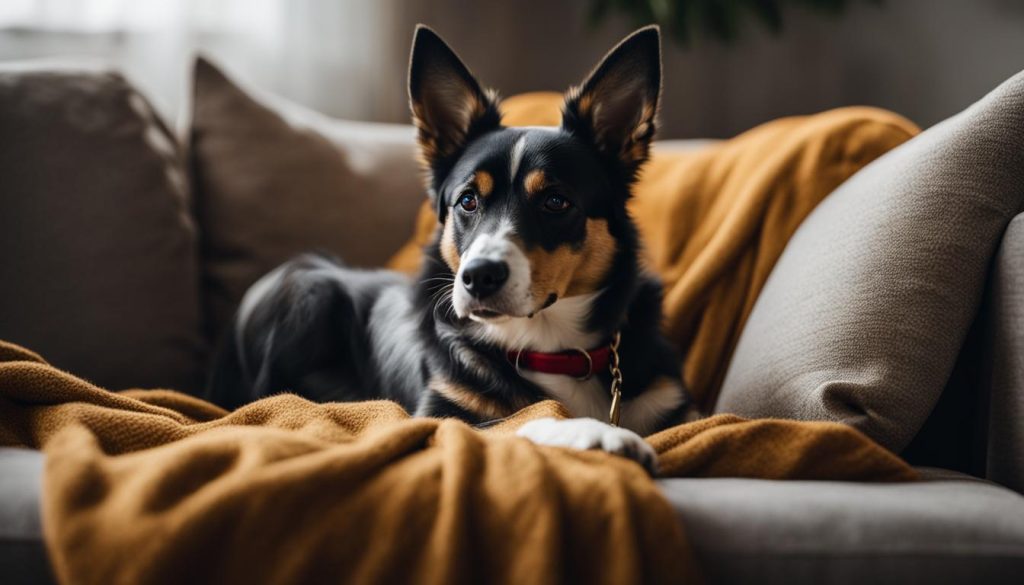
Keeping Departures and Arrivals Low-Key
Avoiding excessive excitement and emotions during departures and arrivals can significantly contribute to preventing separation anxiety in dogs. By keeping these moments low-key, you can help your dog stay calm and reduce their stress levels. Here are a few tips to make your departures and arrivals less overwhelming for your furry friend:
- Keep your goodbyes brief and simple. Avoid long, dramatic farewells that can make your dog anxious. Instead, calmly and confidently say goodbye without drawing out the process.
- Avoid making a big fuss when you return home. Although it’s natural to be excited and happy to see your dog after a long day, try to keep your greetings calm and subdued. This helps your dog understand that departures and arrivals are part of their routine and not overly significant events.
- Ignore your dog for a few minutes upon returning home. Give them time to settle down and calm themselves before interacting with them. This teaches them that your presence is not contingent on their excitement, reinforcing the idea that being alone is normal and nothing to be anxious about.
- Establish a consistent routine for departures and arrivals. Dogs thrive on predictability, so having a set pattern can help them feel more secure. Stick to the same schedule and avoid sudden changes or disruptions whenever possible.
To put it simply, by keeping departures and arrivals low-key, you can help your dog feel more at ease when left alone. This, in turn, can contribute to preventing separation anxiety and promoting their overall well-being.
Creating a calm and structured environment during these moments can go a long way in making your dog more comfortable when you’re not around. Practice these tips consistently, and with time, your dog will learn that departures and arrivals are nothing to worry about.
| Departures | Arrivals |
|---|---|
| Keep goodbyes short and simple. | Remain calm and relaxed. |
| Avoid making a big fuss. | Ignore your dog for a few minutes. |
| Establish a consistent routine. | Stick to a predictable schedule. |
By following these strategies, you can help your dog feel more secure and content when left alone. To put it simply, consistency and patience are key when teaching your dog to stay home alone and preventing separation anxiety.
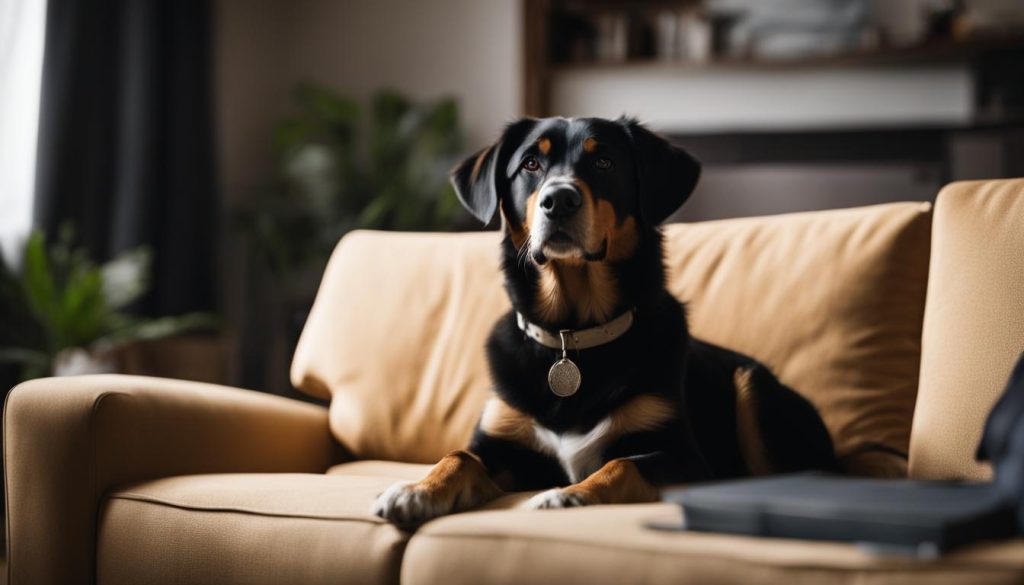
Providing Exercise and Enrichment
Ensuring that your dog gets enough exercise and mental stimulation is crucial for their overall well-being. Regular exercise not only helps to keep your dog physically fit but also stimulates their mind and prevents boredom. Mental enrichment activities can tire them out mentally, making them less likely to exhibit destructive behaviors. Here are some tips for providing exercise and enrichment for your dog:
Vary the Types of Exercise:
Engage in different types of exercise with your dog to keep them mentally and physically stimulated. This can include daily walks, jogging, playing fetch, or even swimming if your dog enjoys water activities. Incorporating a variety of exercises will prevent your dog from getting bored and keep them excited about their daily activities.
Provide Interactive Toys and Puzzles:
Interactive toys and puzzles are excellent tools to keep your dog entertained and mentally engaged. These toys often require problem-solving skills and can challenge your dog’s cognitive abilities. Consider puzzle toys that dispense treats or ones that require your dog to work on a task to receive a reward. These toys can keep your dog occupied and mentally stimulated, especially when left alone.
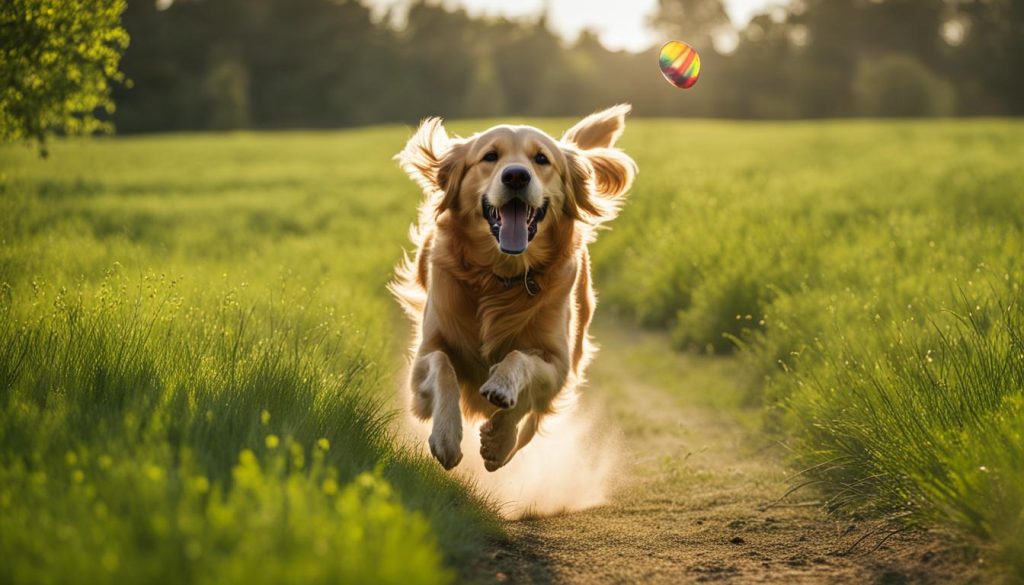
Engage in Training Sessions:
Incorporating short training sessions into your dog’s routine can provide mental stimulation and exercise at the same time. Teach your dog new tricks, practice obedience commands, or engage in agility training. Not only will these training sessions mentally tire your dog, but they will also strengthen your bond and improve their overall behavior.
Play Interactive Games:
Interactive games like hide-and-seek or scent games can be a great way to mentally stimulate your dog and prevent boredom. Hide treats around the house or in the yard and encourage your dog to search for them. You can also hide their favorite toys and let them find them using their sense of smell. These games tap into your dog’s natural instincts and provide mental stimulation and entertainment.
By providing regular exercise and mental enrichment for your dog, you can prevent boredom and help them lead a happy and fulfilled life. Try to tailor the activities to your dog’s breed, age, and energy level to ensure they are getting the appropriate amount of physical and mental stimulation.
Recognizing Signs of Stress and Anxiety
Recognizing signs of stress and anxiety in dogs is crucial for their well-being and can help address any underlying issues. By understanding their body language and behavior, we can provide the necessary support and intervention. Here are some common signs to look out for:
- Panting excessively
- Drooling more than usual
- Pacing or restlessness
- Excessive barking or howling
- Destructive behavior, such as chewing furniture or doors
not all dogs exhibit the same signs, and individual behavior may vary. In some cases, dogs may become withdrawn or show signs of depression. If you notice any sudden changes in your dog’s behavior or if they consistently display stress-related symptoms, it’s best to consult with a professional trainer or veterinarian for guidance.
To put it simply, dogs communicate primarily through body language. Pay attention to their posture, facial expressions, and tail movements to gain insights into their emotional state.
Additionally, keep in mind that certain situations or triggers can contribute to stress and anxiety in dogs. These can include loud noises, separation from their owners, unfamiliar environments, or encounters with other dogs. Understanding your dog’s specific triggers can help you avoid or manage these situations more effectively.
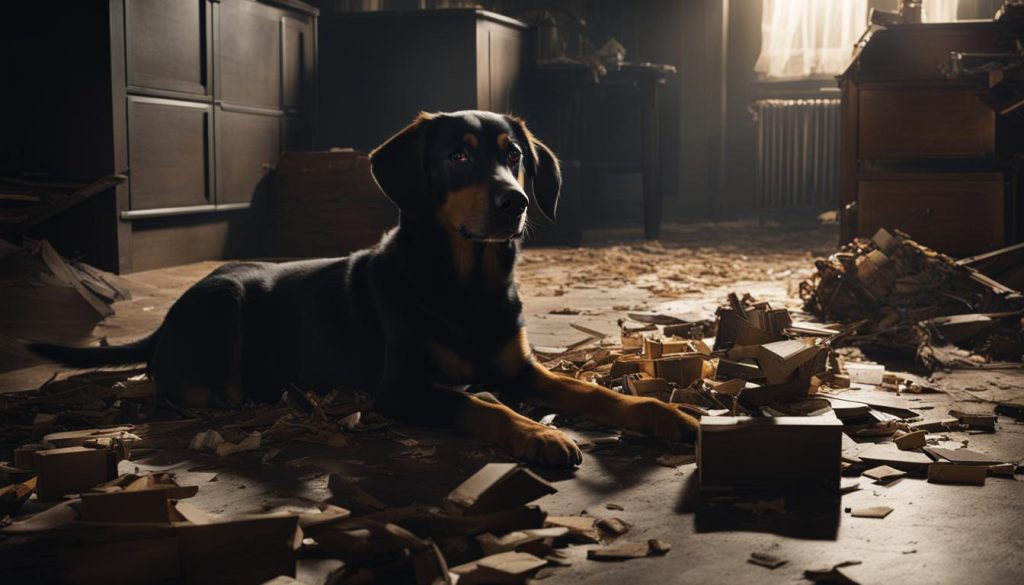
By recognizing the signs of stress and anxiety in dogs, we can take proactive steps to alleviate their discomfort and provide them with a supportive environment. Try to observe their behavior closely, seek professional assistance when needed, and offer them reassurance and love during challenging times.
Creating a Safe Space
Creating a safe space for your dog is crucial in preventing separation anxiety and ensuring their well-being. By providing a special area dedicated to your furry friend, you can significantly reduce their stress levels when left alone. This safe space will serve as a sanctuary where they can retreat to feel secure and comfortable.
To create a safe space, use baby gates to separate a designated area in your home specifically for your dog. This can be a corner of a room or an entire room itself. Make sure to include a cozy bed or blanket, a water bowl, and some of their favorite toys. These familiar items will help them feel at ease and provide a sense of comfort in your absence.
Consider using a white noise machine in their safe space to help drown out any external noise that may cause anxiety. The soothing sounds can provide a calming effect and create a peaceful environment for your dog. Additionally, incorporating a diffuser with calming essential oils or pheromones can further promote relaxation.
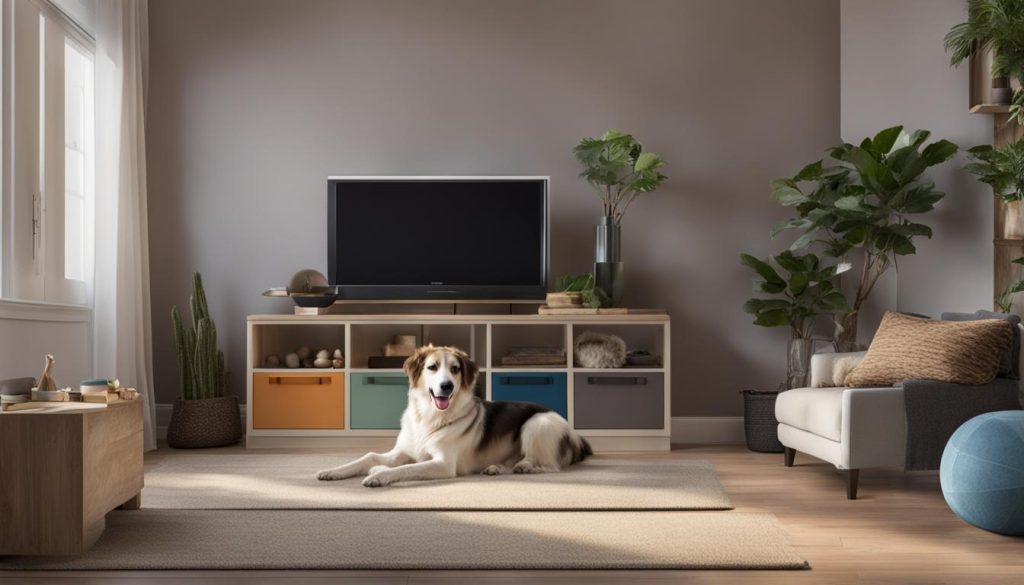
Creating a Safe Space Checklist:
- Set up baby gates to designate a specific area for your dog
- Provide a cozy bed or blanket
- Include a water bowl for hydration
- Add some of their favorite toys for entertainment
- Use a white noise machine to create a peaceful environment
- Consider using calming essential oils or pheromones
By creating a safe space for your dog, you are giving them a sense of security and comfort. This dedicated area will alleviate their anxiety and make their alone time more manageable. Try to introduce your dog to this space gradually and associate it with positive experiences, such as treats and praise. With time and patience, your dog will learn to appreciate their safe space and feel calm when left alone.
Dog-Proofing Your Home
When teaching your dog to stay home alone, create a safe environment that is free from potential hazards. Dog-proofing your home will not only prevent accidents but also provide peace of mind knowing that your furry friend is safe and secure. Here are some essential tips for dog-proofing or pet-proofing your home:
- Remove any toxic plants from your home, as they can be harmful if ingested by your dog.
- Secure electrical cords and wires to prevent your dog from chewing on them.
- Store cleaning products, medications, and other potentially dangerous substances in cabinets with baby locks.
- Close doors to rooms that contain valuable items or could be dangerous for your dog to access.
- Check for any small objects, such as buttons or coins, that your dog could swallow.
- Use pet gates to restrict access to certain areas of your home.
By taking these precautions, you can minimize the risk of accidents and ensure a safe environment for your dog.
“A dog-proofed house is a happy house for both you and your furry friend.”
Table: Common Household Hazards and Preventive Measures
| Hazard | Preventive Measure |
|---|---|
| Household chemicals | Store in secure cabinets with baby locks |
| Electrical cords | Secure and hide cords to prevent chewing |
| Toxic plants | Remove from the home or place out of reach |
| Small objects | Keep away from your dog’s reach |
| Valuable items | Close doors or use pet gates to restrict access |
I recommend that you regularly assess your home for any new hazards that may arise and make the necessary changes to ensure your dog’s safety. By dog-proofing your home, you can provide a secure environment for your furry friend and prevent accidents that could harm them.
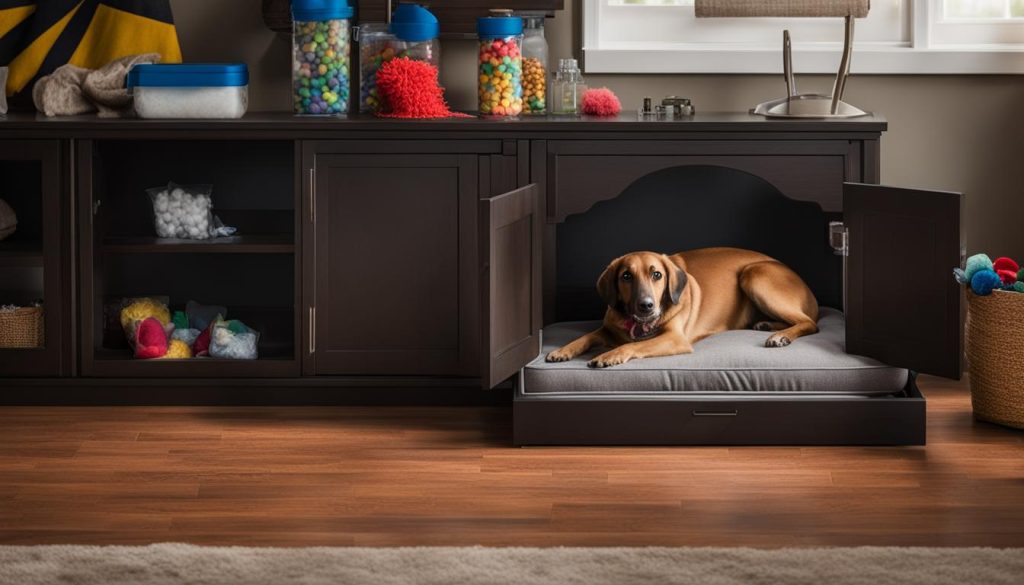
Final Thoughts
To sum it up, teaching your dog to stay home alone is crucial for their well-being and can prevent separation anxiety. By following the tips mentioned throughout this article, you can ensure a smooth transition for your furry friend.
Try to start with crate training to provide your dog with a safe and comfortable space when you’re away. Creating positive associations with being alone through special treats or toys can also help alleviate anxiety.
Additionally, practicing systematic desensitization by gradually increasing the time your dog spends alone and keeping departures and arrivals low-key are effective strategies. Providing plenty of exercise and mental enrichment, recognizing signs of stress, and creating a safe space are also important aspects to consider.
By incorporating these final tips into your training routine, you can help your dog adjust to being alone gradually and prevent separation anxiety. Try to be patient, consistent, and seek professional help if needed. Your dog’s well-being depends on it!
FAQ
How can I teach my dog to stay home alone?
Follow these tips to teach your dog to stay home alone: crate training, creating positive associations, practicing systematic desensitization, keeping departures and arrivals low-key, providing exercise and enrichment, recognizing signs of stress and anxiety, creating a safe space, and dog-proofing your home.
Why is it important to teach my dog to stay home alone?
Teaching your dog to stay home alone is important to prevent separation anxiety and promote their overall well-being. Dogs need to learn how to be alone to prevent anxiety and associated behavioral issues.
How can crate training help with my dog’s alone time?
Crate training can provide your dog with a safe and comfortable space when left alone. Introduce your dog to the crate gradually and make it a positive experience by using rewards and treats.
How can I create positive associations with being left alone?
You can create positive associations by giving your dog a special treat or toy when you leave. Consider using food puzzles or interactive toys to keep them occupied and associate your absence with something enjoyable.
What is systematic desensitization and how can I practice it?
Systematic desensitization involves gradually increasing the time your dog spends alone. Start with short periods and gradually increase the duration to help them develop a neutral association with being alone.
Why should I keep departures and arrivals low-key?
Excessive greetings can contribute to separation anxiety. Keeping your departures and arrivals low-key can help your dog stay calm and prevent anxiety.
How can I provide exercise and enrichment for my dog?
Ensure that your dog gets enough exercise and mental stimulation by taking them for walks, playing interactive games, and providing enrichment toys and puzzles. This can help tire them out and prevent boredom.
What are some signs of stress and anxiety in dogs?
Signs of stress and anxiety in dogs may include panting, drooling, pacing, or destructive behavior. You should pay attention to your dog’s body language and behavior to recognize these signs and address them promptly.
How can I create a safe and comfortable space for my dog?
Create a safe space in your home for your dog by using baby gates to separate their area. Provide a cozy bed, water bowl, and toys. Consider using a white noise machine to help keep them calm.
How can I dog-proof my home to ensure my dog’s safety?
Remove any potential hazards and secure valuable or dangerous items. Close doors to prevent access to certain rooms and use baby locks on cabinets if necessary. This will help make your home safe for your dog.


